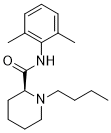
Levobupivacaine is an amide-type local anaesthetic. Levobupivacaine acts via blockade of voltage-sensitive ion channels in neuronal membranes, preventing transmission of nerve impulses. Levobupivacaine also displays activity on cardiac ion channels. In isolated ventricular myocytes, the apparent affinity for inactivated state of the sodium channel is 4.8 μM for Levobupivacaine, with a calculated KD of 39 μM. Levobupivacaine is metabolized by hepatic cytochrome P450 (CYP450) enzymes in vivo. Levobupivacaine can also induce ferroptosis by miR-489-3p/SLC7A11 signaling in gastric cancer.
In vivo, Levobupivacaine has similar nerve blocking potency with bupivacaine. Levobupivacaine at a dose of 0.125%, inhibits motor and nocifensive pinch responses with maximum %MPE of 99 and 68 respectively, and inhibits the duration of deficits of motor and nocifensive pinch responses (60 and 30 , respectively) after sciatic nerve block.
| Molecular Weight | 288.43 |
| Formula | C18H28N2O |
| CAS Number | 27262-47-1 |
| Solubility (25°C) | DMSO: 10 mM |
| Storage |
Powder -20°C 3 years ; 4°C 2 years In solvent -80°C 6 months ; -20°C 1 month |
| Species | Mouse | Rat | Rabbit | Guinea pig | Hamster | Dog |
| Weight (kg) | 0.02 | 0.15 | 1.8 | 0.4 | 0.08 | 10 |
| Body Surface Area (m2) | 0.007 | 0.025 | 0.15 | 0.05 | 0.02 | 0.5 |
| Km factor | 3 | 6 | 12 | 8 | 5 | 20 |
| Animal A (mg/kg) = Animal B (mg/kg) multiplied by | Animal B Km |
| Animal A Km |
For example, to modify the dose of Compound A used for a mouse (20 mg/kg) to a dose based on the BSA for a rat, multiply 20 mg/kg by the Km factor for a mouse and then divide by the Km factor for a rat. This calculation results in a rat equivalent dose for Compound A of 10 mg/kg.
| Related Animal experimental anesthetics Products |
|---|
| Orthocaine
Orthocaine is a local anesthetic agent. |
| Tolycaine
Tolycaine is an amide local anaesthetic. Tolycaine exhibits good anesthetic effects on mice. |
| Etidocaine hydrochloride
Etidocaine hydrochloride is an amino acidamide that acts as a local anesthetic with fast onset and long-acting properties. |
| Lidocaine N-ethyl bromide
Lidocaine N-ethyl bromide is a blocker of non-membrane-permeable,and Inhibits Acid-Induced Activation of Esophageal Nociceptive C Fiber Neurons. |
| MS-222
Tricaine methanesulfonate (MS-222) is common used to immobilize fish for marking or transport and to suppress sensory systems during invasive procedures. |


Products are for research use only. Not for human use. We do not sell to patients.
© Copyright 2010-2023 AbMole BioScience. All Rights Reserved.
